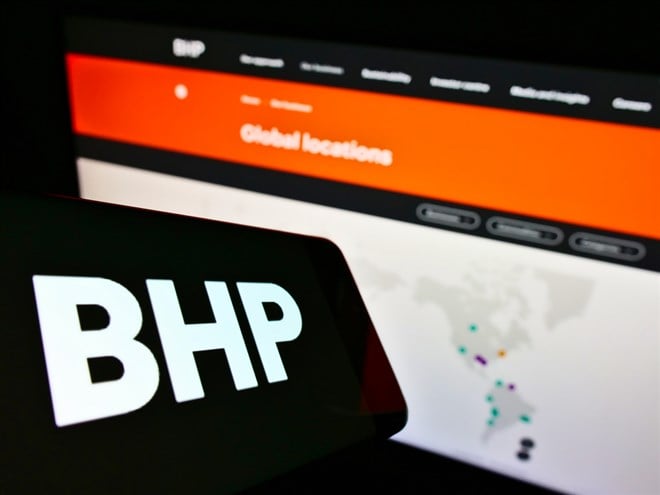
BHP Group Limited (NYSE: BHP) stock and dividend are interesting for their history and high yield. What to know about BHP stock and dividend is that this is one of the world’s largest mining operations, it is fundamental to the global supply chain, and it pays a safe dividend. The dividend is managed by a distribution plan that seeks to return a high level of capital to shareholders while maintaining fiscal discipline and a healthy balance sheet.
Let's dig in to help you make an informed decision about this stock and how it may fit into your high-yield portfolio.
About BHP Energy
BHP Energy is, or was, the petroleum branch of BHP Group Limited. The assets included in BHP Energy were merged with Woodside in an all-stock exchange in 2022. The merger created a stand-alone company and allowed BHP to divest itself of the last of its non-core assets, so it could focus on mining. BHP investors received shares of Woodside in the form of a dividend. Woodside
BHP Stock Overview
BHP Group Limited was formed by the merger of BHP and Billiton plc, founded in the 1880s in Australia’s mining Outback. BHP and Billiton operated independently until 2001. At that time, the company engaged in an aggressive round of acquisitions that expanded its reach within Australia and grew the business into international operations and even oil production.
The merger created one of the world’s largest mining operations, but it has since been pared back from #1 to #2 in terms of revenue. The company began divesting itself of non-core assets and other dead weight in 2017, leaving it leaner and more profitable. That includes the merger and spin-off of the energy assets and under-producing and difficult-to-operate mining locations.
Today, the company operates in five segments: Nickel, Iron Ore, Coal and Copper. Each segment produces secondary minerals but is focused on the primary target. The company’s operations are centered in Australia and include over 2 dozen mines in 5 of the 10 Australian territories. Operations outside Australia are scattered worldwide, including mines in Canada, the US, Mexico, Brazil, Chile and Algeria.
BHP was a dual-listed company with shares traded on the London Stock Exchange and the Australian Stock Exchange. The company relinquished that status in 2022 and is now traded solely on the Australian Exchange.
Price History and Performance: BHP
BHP Group stock price history is volatile, showing the impacts of shifting commodity prices and the company’s restructuring efforts over the past two decades. The takeaway for today is the company’s business is supported by the market and long-term demand for industrial metals but revenue, earnings and dividends may fluctuate over time.
What is the stock price of BHP? The better question is, what are the earnings looking like, and how does that affect the dividend? When it comes to volatility and when should you sell dividend stocks, long-term investors should view price pullbacks as times to buy more shares.
Earnings and Revenue
BHP Group Limited produced more than USD 54 billion in revenue for fiscal 2022, and the outlook is bright. Although there is a risk of global recession going into 2023, the long-term global outlook for steel and industrial metals remains strong.
Earnings for the year topped $12.00 per share and fueled dividends for $6.50 or nearly 10% in yield. Why buy dividend stocks? In this case, it’s the 10% yield and outlook for reliable payments, if not a steady payout.
Dividend Safety
BHP stock dividend is safe because it is a managed distribution. How dividend stocks work is to pay investors profits, but the company needs to maintain its health. This company aims to pay 50% of its earnings which is a manageable and safe figure that allows for growth, but there is a risk.
Earnings are impacted by demand, commodity prices and the cost of production, so they may vary from quarter to quarter. This may result in an erratic distribution amount or even a decline in the payout. Something that can mitigate this is to own more than one dividend stock, but how many dividend stocks to own is up to each investor.
Dividend Reinvestment Program
Investing in top dividend stocks is time-consuming, but BHP investors can participate in a dividend reinvestment program or DRIP. The plan is available to shareholders of record. Dividends will be used to purchase shares in tandem with the distribution, and shares will be delivered to shareholder accounts.
BHP Energy Dividend History
BHP Billiton stock has a robust history of dividend payments and dividend growth. The company has been paying a dividend since 1984 and tends to increase it over time. The catch is that the company pays its dividend twice annually versus the usual quarterly payments and has a dividend policy.
The company aims to pay out at least 50% of earnings at each pay period and may pay more if the board deems it appropriate. The pay periods are in March and September, with declarations coming out the month before.
BHP Energy Limited Competitors
BHP competitors include companies like Glencore plc, Rio Tinto and Vale. These comprise the top five mining companies worldwide, including China’s Shenhua Energy. Glencore’s operations are more than 5X as large as BHP and span a much larger footprint. BHP is focused on Australia, with some operations in North America and elsewhere.
Dividend Capture Strategy for BHP Stock
The dividend capture strategy for BHP stock is simple to execute and aims to earn or “capture” the dividend by owning it for the shortest time. The strategy is centered on some important dates, including Declaration Day, the ex-Dividend Day and the Day of Record.
- Dividend Declaration Day is when the company announces or declares that it will pay an upcoming dividend. The declaration may come alongside, before or after the quarterly earnings report and includes the dividend amount, the ex-dividend day, the date of record and the day of distribution.
- Ex-Dividend Day is the last day an investor can buy the stock and receive the dividend. The only requirement is that investors buy the stock on that day and be owners at the close of trading. This day is usually at least a few days, if not a week or 2 or even a month after the declaration.
- The Date of Record is the day after the ex-dividend day. This is the first day an investor buying the stock will not get the upcoming dividend payment. Investors who own the stock before the start of trading, those who bought on the ex-dividend day, will be recorded as eligible for the dividend. Everyone else will have to wait until the next dividend declaration.
- The Date of Distribution is the day the company will pay or distribute its dividend to shareholders. Any shareholder at the end of trading on the ex-dividend day will receive the dividend regardless of whether or not they own the stock at that time.
I’m sure by now it is easy to see that the dividend capture strategy can be attractive. After all, you can earn a high quarterly yield with BHP stock, but there are risks. Investors may find themselves holding the stock for more than just 1 day because the stock price tends to fall on the day of record. This is because the stock is now trading without the value of the dividend, and those looking to “capture” the dividend may already be selling.
Future Growth for BHP Group
BHP Group growth is tied to the demand and price for its metals. Because its metals are the base ingredient for modern industry, it will be in demand for the foreseeable future.
The growth trajectory is upward because of the growing global population, the modernization of under-developed regions and the maintenance of existing infrastructure, but the company will see ups and downs driven by demand and business cycles
BHP Group Limited, A High Yield With Risks
BHP Group Limited is a great company with a solid business that is fundamentally important to the entire global supply chain. Without the metal this company produces, there would be a lot less steel, aluminum and industrial metals in the world but there are risks for inventors.
The company’s stock price is volatile, and the dividend is erratic. The company can be counted on to pay a dividend, but when and how much is the question. The good news is that distributions are trending higher over the long term if showing volatility on a payment-to-payment basis.
FAQs
Is BHP a good stock to buy?
Is BHP a good stock to buy? That depends on the account, the investors and the strategy. BHP is the world’s 2nd largest mining company and is a good stock to buy. Investors looking for safety, reliable dividends and a low beta may wish to look elsewhere.
Is BHP stock overvalued?
BHP stock price tends to trade at fair value because the commodity market and its business are very closely watched. However, this leads to volatility because the commodities market tends to change rapidly due to imbalances in supply and demand.
What is the forecast for BHP shares?
BHP shares tend to move in tandem with commodity prices and demand, so they may experience volatility in the near, mid and long term. Shares of BHP have been trading in a wide range since 2005 and should be expected to continue moving within that range.





